Deck 14: The Expansion of Space
Question
Question
Question
Question
Question
Question
Question
Question
Question
Question
Question
Question
Question
Question
Question
Question
Question
Question
Question
Question
Question
Question
Question
Question
Question
Question
Question
Question
Question
Question
Question
Question
Question
Question
Question
Question
Question
Question
Question
Question
Question
Question
Question
Question
Question
Question
Question
Question
Question
Question
Question
Question
Question
Question
Question
Question
Question
Question
Question
Question
Question
Question
Question
Question
Question
Question
Question
Question
Question
Question
Question

Unlock Deck
Sign up to unlock the cards in this deck!
Unlock Deck
Unlock Deck
1/71
Play
Full screen (f)
Deck 14: The Expansion of Space
1
The figure below indicates a possible picture of a theoretical universe with two separate observers within it.Which of the following statements describes this universe? 
A) This universe is homogeneous but not isotropic.
B) This universe is isotropic but not homogeneous.
C) This universe is both homogeneous and isotropic.
D) This universe is neither homogeneous nor isotropic.

A) This universe is homogeneous but not isotropic.
B) This universe is isotropic but not homogeneous.
C) This universe is both homogeneous and isotropic.
D) This universe is neither homogeneous nor isotropic.
This universe is homogeneous but not isotropic.
2
In the Great Debate of 1920,Curtis argued that spiral nebulae were individual galaxies,while Shapley argued spiral nebulae must be part of the Milky Way because the Milky Way was very large in size.
True
3
The Cosmological Principle says that physical laws that are true in one part of the universe must be true in every part of the universe.
True
4
When we measure distances to very faint galaxies with Type Ia supernovae,the accuracy of the measurement is only as good as that of the calibration of the Cepheids.

Unlock Deck
Unlock for access to all 71 flashcards in this deck.
Unlock Deck
k this deck
5
Edwin Hubble revolutionized astronomy when he made an accurate calculation of the distance to the Andromeda Nebula by spotting a rare Type Ia supernova.

Unlock Deck
Unlock for access to all 71 flashcards in this deck.
Unlock Deck
k this deck
6
The abundance of various elements formed from Big Bang nucleosynthesis depended only on the temperature of normal matter in the early universe.

Unlock Deck
Unlock for access to all 71 flashcards in this deck.
Unlock Deck
k this deck
7
There is no special center to the expansion of the universe.

Unlock Deck
Unlock for access to all 71 flashcards in this deck.
Unlock Deck
k this deck
8
The cosmic microwave background radiation contains photons left over from the epoch in the universe's history when electrons recombined with nuclei.

Unlock Deck
Unlock for access to all 71 flashcards in this deck.
Unlock Deck
k this deck
9
In the Great Debate of 1920,Curtis and Shapley argued over whether or not:
A) the Big Bang occurred
B) the age of the universe was 14 billion years
C) the spiral nebulae were located outside the Milky Way
D) life existed outside of Earth
A) the Big Bang occurred
B) the age of the universe was 14 billion years
C) the spiral nebulae were located outside the Milky Way
D) life existed outside of Earth

Unlock Deck
Unlock for access to all 71 flashcards in this deck.
Unlock Deck
k this deck
10
The current temperature of the cosmic microwave background radiation is 17 K.

Unlock Deck
Unlock for access to all 71 flashcards in this deck.
Unlock Deck
k this deck
11
The figure below shows the spectrum of a star whose motion compared to our star is nearly stationary within the Milky Way Galaxy.The shift in the galaxy spectrum indicates that the galaxy is moving quickly toward our own.
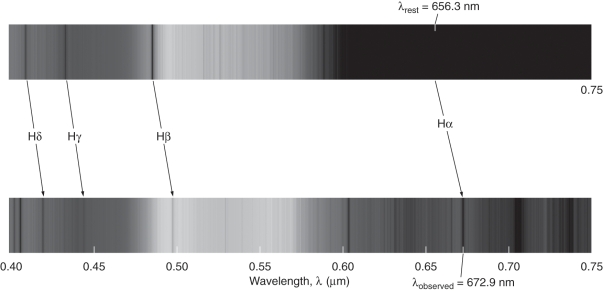


Unlock Deck
Unlock for access to all 71 flashcards in this deck.
Unlock Deck
k this deck
12
The figure below indicates a possible picture of a theoretical universe with two separate observers within it.Which of the following statements describes this universe? 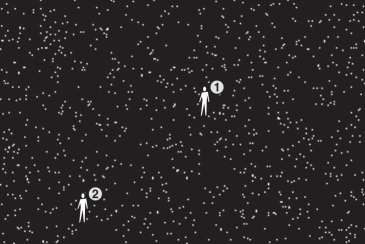
A) This universe is homogeneous but not isotropic.
B) This universe is isotropic but not homogeneous.
C) This universe is both homogeneous and isotropic.
D) This universe is neither homogeneous nor isotropic.

A) This universe is homogeneous but not isotropic.
B) This universe is isotropic but not homogeneous.
C) This universe is both homogeneous and isotropic.
D) This universe is neither homogeneous nor isotropic.

Unlock Deck
Unlock for access to all 71 flashcards in this deck.
Unlock Deck
k this deck
13
The only chemical elements that formed as the universe cooled down after the Big Bang were hydrogen,deuterium,and helium.

Unlock Deck
Unlock for access to all 71 flashcards in this deck.
Unlock Deck
k this deck
14
The value of the scale factor RU depends on the value of redshift z.

Unlock Deck
Unlock for access to all 71 flashcards in this deck.
Unlock Deck
k this deck
15
The figure below indicates a possible picture of a theoretical universe with two separate observers within it.Which of the following statements describes this universe? 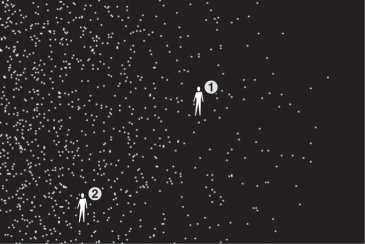
A) This universe is homogeneous but not isotropic.
B) This universe is isotropic but not homogeneous.
C) This universe is both homogeneous and isotropic.
D) This universe is neither homogeneous nor isotropic.

A) This universe is homogeneous but not isotropic.
B) This universe is isotropic but not homogeneous.
C) This universe is both homogeneous and isotropic.
D) This universe is neither homogeneous nor isotropic.

Unlock Deck
Unlock for access to all 71 flashcards in this deck.
Unlock Deck
k this deck
16
What do astronomers mean when they say that the universe is homogeneous?
A) All stars in all galaxies have planetary systems just like ours.
B) The universe looks the same no matter where you look.
C) Galaxies are generally distributed similarly throughout the universe.
D) Generally speaking,there is little difference between conditions on Earth,in the Sun,or in outer space.
A) All stars in all galaxies have planetary systems just like ours.
B) The universe looks the same no matter where you look.
C) Galaxies are generally distributed similarly throughout the universe.
D) Generally speaking,there is little difference between conditions on Earth,in the Sun,or in outer space.

Unlock Deck
Unlock for access to all 71 flashcards in this deck.
Unlock Deck
k this deck
17
As the universe expands,the sizes of galaxies expand a measurable amount as well.

Unlock Deck
Unlock for access to all 71 flashcards in this deck.
Unlock Deck
k this deck
18
We can measure the value of H0 directly with no intermediate steps.

Unlock Deck
Unlock for access to all 71 flashcards in this deck.
Unlock Deck
k this deck
19
The apparent recessional velocities of galaxies at large distances are due mainly to the actual motions of the galaxies through space.

Unlock Deck
Unlock for access to all 71 flashcards in this deck.
Unlock Deck
k this deck
20
The standard Big Bang theory successfully predicts that the fraction of helium by mass in the primordial universe was 2 percent.

Unlock Deck
Unlock for access to all 71 flashcards in this deck.
Unlock Deck
k this deck
21
The spectra of most galaxies tell us that:
A) most galaxies appear to be moving away from us
B) their light comes predominantly from objects other than stars
C) most galaxies contain clouds of gas that are absorbing their favorite wavelengths
D) galaxies in the past rotated at a faster rate than they do today
A) most galaxies appear to be moving away from us
B) their light comes predominantly from objects other than stars
C) most galaxies contain clouds of gas that are absorbing their favorite wavelengths
D) galaxies in the past rotated at a faster rate than they do today

Unlock Deck
Unlock for access to all 71 flashcards in this deck.
Unlock Deck
k this deck
22
Why can Type Ia supernovae be used to determine a galaxy's distance?
A) Type Ia supernovae occur only in very luminous galaxies.
B) Type Ia supernova have approximately the same luminosity.
C) Type Ia supernovae have approximately the same size.
D) A Type Ia supernova occurs in a typical galaxy about once every 100 years.
A) Type Ia supernovae occur only in very luminous galaxies.
B) Type Ia supernova have approximately the same luminosity.
C) Type Ia supernovae have approximately the same size.
D) A Type Ia supernova occurs in a typical galaxy about once every 100 years.

Unlock Deck
Unlock for access to all 71 flashcards in this deck.
Unlock Deck
k this deck
23
Where in the universe did the Big Bang take place?
A) Near the Milky Way Galaxy
B) Near the Virgo cluster
C) Near some unknown location on the other side of the universe
D) Everywhere in the universe
A) Near the Milky Way Galaxy
B) Near the Virgo cluster
C) Near some unknown location on the other side of the universe
D) Everywhere in the universe

Unlock Deck
Unlock for access to all 71 flashcards in this deck.
Unlock Deck
k this deck
24
Type Ia supernovae have an absolute magnitude of -20.If you discover a Type Ia supernova in a distant galaxy that has an apparent magnitude of 22,then how far away is this galaxy?
A) 0.3 Mpc
B) 40 Mpc
C) 1,200 Mpc
D) 2,500 Mpc
A) 0.3 Mpc
B) 40 Mpc
C) 1,200 Mpc
D) 2,500 Mpc

Unlock Deck
Unlock for access to all 71 flashcards in this deck.
Unlock Deck
k this deck
25
The figure below indicates a possible picture of a theoretical universe filled with galaxies moving as shown with two separate observers within it.Which of the following statements describes this universe? 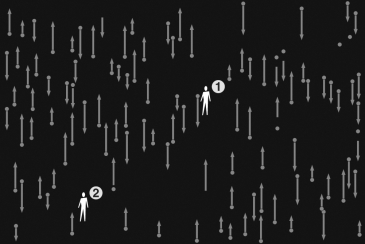
A) This universe is homogeneous but not isotropic.
B) This universe is isotropic but not homogeneous.
C) This universe is both homogeneous and isotropic.
D) This universe is neither homogeneous nor isotropic.

A) This universe is homogeneous but not isotropic.
B) This universe is isotropic but not homogeneous.
C) This universe is both homogeneous and isotropic.
D) This universe is neither homogeneous nor isotropic.

Unlock Deck
Unlock for access to all 71 flashcards in this deck.
Unlock Deck
k this deck
26
Which distance indicator can be used to measure the most distant objects?
A) Cepheids
B) Parallax
C) Type Ia supernovae
D) Main-sequence fitting
A) Cepheids
B) Parallax
C) Type Ia supernovae
D) Main-sequence fitting

Unlock Deck
Unlock for access to all 71 flashcards in this deck.
Unlock Deck
k this deck
27
If we lived on a galaxy one billion light-years from our own,what would we see?
A) A universe 1 billion years younger than ours
B) A universe 1 billion years older than ours
C) Much the same universe we see today
D) Nothing-there are no galaxies one billion light-years away from us
A) A universe 1 billion years younger than ours
B) A universe 1 billion years older than ours
C) Much the same universe we see today
D) Nothing-there are no galaxies one billion light-years away from us

Unlock Deck
Unlock for access to all 71 flashcards in this deck.
Unlock Deck
k this deck
28
If suddenly we find that the distance between Earth and the Sun is now 10 percent larger than we thought it was before,what else will change?
A) The distances of stars
B) The size of our galaxy
C) The value of H0
D) All of the above
A) The distances of stars
B) The size of our galaxy
C) The value of H0
D) All of the above

Unlock Deck
Unlock for access to all 71 flashcards in this deck.
Unlock Deck
k this deck
29
To be a standard candle an object must have a constant:
A) lifetime
B) brightness
C) luminosity
D) distance
A) lifetime
B) brightness
C) luminosity
D) distance

Unlock Deck
Unlock for access to all 71 flashcards in this deck.
Unlock Deck
k this deck
30
What did Edwin Hubble study in the Andromeda Galaxy that proved it was an individual galaxy and not part of our own Milky Way?
A) Cepheid stars
B) Type Ia supernovae
C) Globular clusters
D) Red Giant stars
A) Cepheid stars
B) Type Ia supernovae
C) Globular clusters
D) Red Giant stars

Unlock Deck
Unlock for access to all 71 flashcards in this deck.
Unlock Deck
k this deck
31
Which of the following lists distance indicators that are used to measure distances ranging from the very nearest to the very farthest?
A) Cepheids,parallax,main-sequence fitting,Type Ia supernovae
B) Parallax,main-sequence fitting,Cepheids,Type Ia supernovae
C) Parallax,main-sequence fitting,Type Ia supernovae,Cepheids
D) Main-sequence fitting,parallax,Cepheids,Type Ia supernovae
A) Cepheids,parallax,main-sequence fitting,Type Ia supernovae
B) Parallax,main-sequence fitting,Cepheids,Type Ia supernovae
C) Parallax,main-sequence fitting,Type Ia supernovae,Cepheids
D) Main-sequence fitting,parallax,Cepheids,Type Ia supernovae

Unlock Deck
Unlock for access to all 71 flashcards in this deck.
Unlock Deck
k this deck
32
If you measured the distances and recessional velocities for a sample of galaxies and plotted the data to get the figure below,what value would you derive for the Hubble constant? 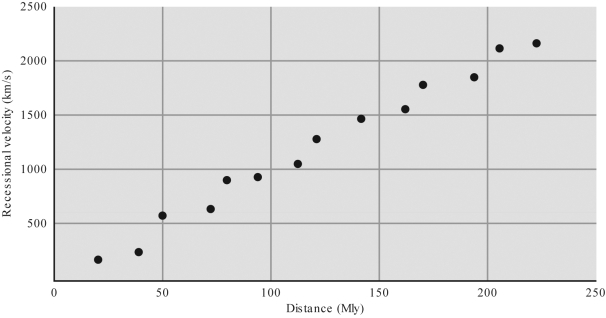
A) 10 km/s/Mly
B) 22 km/s/Mly
C) 45 km/s/Mly
D) 100 km/s/Mly

A) 10 km/s/Mly
B) 22 km/s/Mly
C) 45 km/s/Mly
D) 100 km/s/Mly

Unlock Deck
Unlock for access to all 71 flashcards in this deck.
Unlock Deck
k this deck
33
Astronomers have known that galaxies are separate entities outside of our own for roughly the last:
A) 30 years
B) 90 years
C) 150 years
D) 300 years
A) 30 years
B) 90 years
C) 150 years
D) 300 years

Unlock Deck
Unlock for access to all 71 flashcards in this deck.
Unlock Deck
k this deck
34
According to Hubble's law,as the distance of a galaxy __________ its __________ increases.
A) increases; luminosity
B) increases; recessional velocity
C) decreases; luminosity
D) decreases; recessional velocity
A) increases; luminosity
B) increases; recessional velocity
C) decreases; luminosity
D) decreases; recessional velocity

Unlock Deck
Unlock for access to all 71 flashcards in this deck.
Unlock Deck
k this deck
35
Galaxies move away from us in all directions because:
A) the force of gravity strengthens with distance
B) the force of gravity weakens with distance
C) space is expanding
D) our galaxy has expelled all other galaxies
A) the force of gravity strengthens with distance
B) the force of gravity weakens with distance
C) space is expanding
D) our galaxy has expelled all other galaxies

Unlock Deck
Unlock for access to all 71 flashcards in this deck.
Unlock Deck
k this deck
36
Hubble's constant,H0,represents:
A) the rate of expansion of the universe
B) the speed at which galaxies are moving away from us
C) the time it takes a galaxy to move twice as far away from us
D) the size of the universe
A) the rate of expansion of the universe
B) the speed at which galaxies are moving away from us
C) the time it takes a galaxy to move twice as far away from us
D) the size of the universe

Unlock Deck
Unlock for access to all 71 flashcards in this deck.
Unlock Deck
k this deck
37
If the distance of a galaxy at a redshift z = 0.5 is 1,800 Mpc,how many years back into the past are we looking when we observe this galaxy?
A) 500 million years
B) 2 billion years
C) 6 billion years
D) 9 billion years
A) 500 million years
B) 2 billion years
C) 6 billion years
D) 9 billion years

Unlock Deck
Unlock for access to all 71 flashcards in this deck.
Unlock Deck
k this deck
38
Astronomers use galactic redshift as a measure of:
A) gravity
B) distance
C) velocity
D) mass
A) gravity
B) distance
C) velocity
D) mass

Unlock Deck
Unlock for access to all 71 flashcards in this deck.
Unlock Deck
k this deck
39
The inverse of the value of H0 is a:
A) time
B) mass
C) density
D) size
A) time
B) mass
C) density
D) size

Unlock Deck
Unlock for access to all 71 flashcards in this deck.
Unlock Deck
k this deck
40
Why are some galaxies' spectra blueshifted rather than redshifted?
A) Some distant galaxies are gravitationally lensed.
B) Some nearby galaxies are attracted to us because of the mass of the Milky Way.
C) Some nearby galaxies have vigorous star formation and are much bluer than others.
D) Some distant galaxies have AGN at their centers.
A) Some distant galaxies are gravitationally lensed.
B) Some nearby galaxies are attracted to us because of the mass of the Milky Way.
C) Some nearby galaxies have vigorous star formation and are much bluer than others.
D) Some distant galaxies have AGN at their centers.

Unlock Deck
Unlock for access to all 71 flashcards in this deck.
Unlock Deck
k this deck
41
The current temperature of the cosmic background radiation of 2.73 K means that the peak of its spectrum occurs at a wavelength of:
A) 1 m
B) 10 m
C) 100 m
D) 1,000 m
A) 1 m
B) 10 m
C) 100 m
D) 1,000 m

Unlock Deck
Unlock for access to all 71 flashcards in this deck.
Unlock Deck
k this deck
42
Assuming a Hubble time of 13.6 billion years and a constant rate of expansion of the universe,what was the scale factor (RU)of the universe 10.2 billion years ago (compared to today)?
A) 0.25
B) 0.50
C) 0.67
D) 0.75
A) 0.25
B) 0.50
C) 0.67
D) 0.75

Unlock Deck
Unlock for access to all 71 flashcards in this deck.
Unlock Deck
k this deck
43
After the Big Bang,as the universe cooled and protons and electrons combined so that the universe became neutral,what important consequence happened?
A) Photons began to travel freely through the universe.
B) Neutrinos ceased to interact with normal matter.
C) Dark matter ceased to interact with normal matter.
D) Protons and neutrons combined to form nuclei such as deuterium and helium.
A) Photons began to travel freely through the universe.
B) Neutrinos ceased to interact with normal matter.
C) Dark matter ceased to interact with normal matter.
D) Protons and neutrons combined to form nuclei such as deuterium and helium.

Unlock Deck
Unlock for access to all 71 flashcards in this deck.
Unlock Deck
k this deck
44
Which of the following was NOT created as a result of Big Bang nucleosynthesis?
A) Helium
B) Lithium
C) Carbon
D) Deuterium
A) Helium
B) Lithium
C) Carbon
D) Deuterium

Unlock Deck
Unlock for access to all 71 flashcards in this deck.
Unlock Deck
k this deck
45
If the spectrum of a distant galaxy is observed to have a calcium K absorption line that occurs at a wavelength of 500.4 nm,what is this galaxy's distance if the rest wavelength of this absorption line is 393.4 nm?
A) 950 Mly
B) 1,800 Mly
C) 2,300 Mly
D) 3,700 Mly
A) 950 Mly
B) 1,800 Mly
C) 2,300 Mly
D) 3,700 Mly

Unlock Deck
Unlock for access to all 71 flashcards in this deck.
Unlock Deck
k this deck
46
How did Edwin Hubble definitively prove that "spiral nebulae" were individual galaxies that were separate from the Milky Way?

Unlock Deck
Unlock for access to all 71 flashcards in this deck.
Unlock Deck
k this deck
47
What were the positions taken by Heber Curtis and Harlow Shapley in their "Great Debate," and how were both of them partially correct?

Unlock Deck
Unlock for access to all 71 flashcards in this deck.
Unlock Deck
k this deck
48
If you found a galaxy with a hydrogen emission line,normally found at 656.3 nm,with a measured wavelength of 756.3 nm,what would be the galaxy's redshift?
A) 0.01
B) 0.05
C) 0.10
D) 0.15
A) 0.01
B) 0.05
C) 0.10
D) 0.15

Unlock Deck
Unlock for access to all 71 flashcards in this deck.
Unlock Deck
k this deck
49
Which of the following is NOT a prediction of the standard Big Bang theory that has been successfully verified by observations?
A) The universe is expanding.
B) The faintest galaxies look redder because their stars are younger.
C) Helium,lithium,and beryllium were made as the universe cooled after the initial Big Bang.
D) The early universe was very hot and dense.
A) The universe is expanding.
B) The faintest galaxies look redder because their stars are younger.
C) Helium,lithium,and beryllium were made as the universe cooled after the initial Big Bang.
D) The early universe was very hot and dense.

Unlock Deck
Unlock for access to all 71 flashcards in this deck.
Unlock Deck
k this deck
50
In the early 1960s,physicists named Penzias and Wilson detected a persistent noise at a wavelength of 1 mm in their radio telescope.  The persistent noise that Penzias and Wilson detected came from all directions in the sky due to:
The persistent noise that Penzias and Wilson detected came from all directions in the sky due to:
A) synchrotron emission from the Crab Nebula
B) emission from newly formed stars in the Orion Nebula
C) cellphone usage
D) photons left over from the Big Bang
 The persistent noise that Penzias and Wilson detected came from all directions in the sky due to:
The persistent noise that Penzias and Wilson detected came from all directions in the sky due to:A) synchrotron emission from the Crab Nebula
B) emission from newly formed stars in the Orion Nebula
C) cellphone usage
D) photons left over from the Big Bang

Unlock Deck
Unlock for access to all 71 flashcards in this deck.
Unlock Deck
k this deck
51
The cosmic microwave background radiation is a snapshot of the radiation in the universe at a redshift of z 1,000 when the universe was:
A) 1,000 times smaller than it is today
B) 10 times smaller than it is today
C) 2 times smaller than it is today
D) the same size as it is today
A) 1,000 times smaller than it is today
B) 10 times smaller than it is today
C) 2 times smaller than it is today
D) the same size as it is today

Unlock Deck
Unlock for access to all 71 flashcards in this deck.
Unlock Deck
k this deck
52
The existence of the cosmic background radiation tells us that the early universe was:
A) much hotter than it is today
B) much colder than it is today
C) composed entirely of radiation at early times
D) composed entirely of stars at early times
A) much hotter than it is today
B) much colder than it is today
C) composed entirely of radiation at early times
D) composed entirely of stars at early times

Unlock Deck
Unlock for access to all 71 flashcards in this deck.
Unlock Deck
k this deck
53
If you found a galaxy with a hydrogen emission line,normally found at 656.3 nm,with a measured wavelength of 756.3 nm,what would the galaxy's recessional velocity be if the Hubble constant is 22 km/s/Mly?
A) 1,120 km/s
B) 2,080 km/s
C) 6,070 km/s
D) 8,500 km/s
A) 1,120 km/s
B) 2,080 km/s
C) 6,070 km/s
D) 8,500 km/s

Unlock Deck
Unlock for access to all 71 flashcards in this deck.
Unlock Deck
k this deck
54
Describe the two assumptions regarding the universe that the cosmological principle makes.

Unlock Deck
Unlock for access to all 71 flashcards in this deck.
Unlock Deck
k this deck
55
Does Hubble's law imply that our galaxy is sitting at the center of the universe? Explain.

Unlock Deck
Unlock for access to all 71 flashcards in this deck.
Unlock Deck
k this deck
56
Why is it NOT possible to look all the way back to the Big Bang itself?
A) Photons are not produced until the stars begin to shine at a redshift of z 20.
B) From redshifts of z = 0 to 100,photons are gravitationally lensed by the dark matter in the universe.
C) At redshifts of z > 1,000,most of the photons are blocked by large amounts of cold gas and dust.
D) For redshifts of z > 1,000,photons are heavily altered because they easily react with individual protons and electrons in the universe.
A) Photons are not produced until the stars begin to shine at a redshift of z 20.
B) From redshifts of z = 0 to 100,photons are gravitationally lensed by the dark matter in the universe.
C) At redshifts of z > 1,000,most of the photons are blocked by large amounts of cold gas and dust.
D) For redshifts of z > 1,000,photons are heavily altered because they easily react with individual protons and electrons in the universe.

Unlock Deck
Unlock for access to all 71 flashcards in this deck.
Unlock Deck
k this deck
57
The Sun is 27 percent helium by mass.Where was the majority of this helium manufactured?
A) In Type II supernovae that happened before the Sun formed
B) In low-mass stars that lived and died before the Sun formed
C) In nuclear burning that happened in the Sun's core
D) In the Big Bang
A) In Type II supernovae that happened before the Sun formed
B) In low-mass stars that lived and died before the Sun formed
C) In nuclear burning that happened in the Sun's core
D) In the Big Bang

Unlock Deck
Unlock for access to all 71 flashcards in this deck.
Unlock Deck
k this deck
58
If there were more baryons in the universe immediately after the Big Bang,then the abundance of __________ in stars and galaxies would be higher.
A) hydrogen
B) carbon
C) deuterium
D) helium
A) hydrogen
B) carbon
C) deuterium
D) helium

Unlock Deck
Unlock for access to all 71 flashcards in this deck.
Unlock Deck
k this deck
59
If a galaxy has a recessional velocity of 880 km/s,what is its distance if the Hubble constant is 22 km/s/Mly?
A) 40 Mly
B) 88 Mly
C) 400 Mly
D) 8,800 Mly
A) 40 Mly
B) 88 Mly
C) 400 Mly
D) 8,800 Mly

Unlock Deck
Unlock for access to all 71 flashcards in this deck.
Unlock Deck
k this deck
60
If the distance of a galaxy is 100 Mly,what is its recessional velocity if the Hubble constant is 22 km/s/Mly?
A) 100 km/s
B) 220 km/s
C) 1,000 km/s
D) 2,200 km/s
A) 100 km/s
B) 220 km/s
C) 1,000 km/s
D) 2,200 km/s

Unlock Deck
Unlock for access to all 71 flashcards in this deck.
Unlock Deck
k this deck
61
If the density of normal matter,such as protons and electrons,were higher in the early universe,would there have been more or less 4He made in the Big Bang?

Unlock Deck
Unlock for access to all 71 flashcards in this deck.
Unlock Deck
k this deck
62
Assuming the Hubble constant is equal to 22 km/s/Mly,estimate the age of the universe (or Hubble time).Note that 1 Mly = 9.5 × 1018 km and 1 year = 3.17 × 107 s.

Unlock Deck
Unlock for access to all 71 flashcards in this deck.
Unlock Deck
k this deck
63
The spectrum of a galaxy is observed to have a hydrogen emission line,normally found at 656.3 nm,with a measured wavelength of 856.3 nm.What is its distance if the Hubble constant is 22 km/s/Mly?

Unlock Deck
Unlock for access to all 71 flashcards in this deck.
Unlock Deck
k this deck
64
The cosmic background radiation (CBR)has a temperature of approximately 2.7 K and a Planck blackbody spectrum.Calculate the wavelength where the CBR spectrum peaks.

Unlock Deck
Unlock for access to all 71 flashcards in this deck.
Unlock Deck
k this deck
65
What does the value of RU,the scale factor,tell us?

Unlock Deck
Unlock for access to all 71 flashcards in this deck.
Unlock Deck
k this deck
66
Examine the figure below.Describe why the distance ladder is so important to the field of cosmology.



Unlock Deck
Unlock for access to all 71 flashcards in this deck.
Unlock Deck
k this deck
67
Name three "rungs" in the distance ladder that let us estimate the value of H0.

Unlock Deck
Unlock for access to all 71 flashcards in this deck.
Unlock Deck
k this deck
68
Name two predictions of the standard Big Bang theory that have been verified by observations.

Unlock Deck
Unlock for access to all 71 flashcards in this deck.
Unlock Deck
k this deck
69
The COBE and WMAP satellites (see the figure below)detected fluctuations in the CBR.On average,how big were these fluctuations,and what does that tell us about the very early universe?



Unlock Deck
Unlock for access to all 71 flashcards in this deck.
Unlock Deck
k this deck
70
What important event in the universe's history marked the creation of the cosmic background radiation?

Unlock Deck
Unlock for access to all 71 flashcards in this deck.
Unlock Deck
k this deck
71
The spectrum of a galaxy is observed to have a hydrogen emission line,normally found at 656.3 nm,with a measured wavelength of 928.7 nm.What is its redshift?

Unlock Deck
Unlock for access to all 71 flashcards in this deck.
Unlock Deck
k this deck



